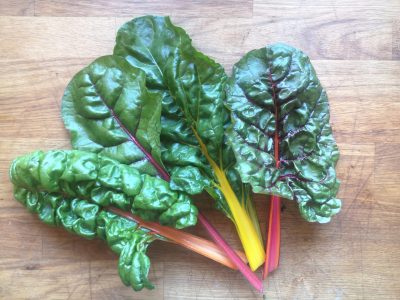Botanical name: Beta vulgaris subsp. cicla var. flavescens
The origins of the chard we know today comes from wild or sea beet, which is often found growing on the shores of Europe, North Africa and West Asia. Botanically speaking, beets are divided into 2 groups; root vegetables and fodder crops (Conditiva group), and chards (Cicla group). The Cicla group includes slender-stalked, flat-bladed spinach beets, and leafy, broad-stemmed silver beets – both often called Swiss chard.

Both the stalk and the leaves of Swiss chard can be eaten. The leaves have a similar green, earthy taste to spinach but with a slightly saltier, less irony tone. They can be substituted for spinach in recipes but will retain more structure when cooked. The stalks of chard are excellent in their own right, having a more delicate flavour and a light, crunchy texture. They can be prepared the same way as celery or asparagus. It is better to separate the leaves from the stems and treat as separate ingredients to ensure even cooking.
Swiss chard is a great source of vitamin K, A and C, as well as rich in minerals and fibre. The leaves have important antioxidant properties that help to protect against cancer, cardiovascular diseases and inflammation.
Personally, my favourite way to use chard is to make cheese and chard muffins, using a big handful of finely chopped chard in the muffin batter mix (my three year old daughter loves them too!). It’s also delicious raw, chopped finely in green salads to add a subtle earthy flavour, or wilted and mixed with pine nuts and raisins in traditional Arabic style.
Why not give chard a try this season!
References:
Madison, D. (2008) Edible: An Illustrated Guide to the World’s Food Plants. Australia: National Geographic .
Marshall, B. (2020) Grow Yourself Healthy: Gardening to Transform Your Gut All Year Round. London: Frances Lincoln.